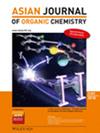近紫外发射含B─o氮杂硼的合成及其光学性质
IF 2.7
4区 化学
Q1 CHEMISTRY, ORGANIC
引用次数: 0
摘要
紫外(UV)有机发光基团因其潜在的生物和工业应用而受到广泛关注。本研究合成了一种新的含硼氧键的二苯并-1,4-氮杂波啉(DBAB)衍生物2BO2Dpa。在甲苯中,2BO2Dpa表现出明显的紫蓝色光致发光,中心为399 nm,最大半宽为17 nm。此外,基于2BO2Dpa的有机发光二极管表现出以404 nm为中心的蓝紫色电致发光,显示了其作为近紫外发射器的应用潜力。本文章由计算机程序翻译,如有差异,请以英文原文为准。



Synthesis and Optical Properties of Near-Ultraviolet-Emissive B─O-Containing Azaborines
Ultraviolet (UV)-emissive organic luminophores have attracted significant attention owing to their potential biological and industrial applications. In this study, a novel dibenzo-1,4-azaborine (DBAB) derivative 2BO2Dpa containing boron-─oxygen bonds were synthesized. In toluene, 2BO2Dpa exhibited a sharp violet-blue photoluminescence centered at 399 nm, with a full width at half maximum of 17 nm. Furthermore, organic light-emitting diodes based on 2BO2Dpa exhibited blue-violet electroluminescence centered at 404 nm, demonstrating their potential for application as near-UV emitters.
求助全文
通过发布文献求助,成功后即可免费获取论文全文。
去求助
来源期刊

Asian Journal of Organic Chemistry
CHEMISTRY, ORGANIC-
CiteScore
4.70
自引率
3.70%
发文量
372
期刊介绍:
Organic chemistry is the fundamental science that stands at the heart of chemistry, biology, and materials science. Research in these areas is vigorous and truly international, with three major regions making almost equal contributions: America, Europe and Asia. Asia now has its own top international organic chemistry journal—the Asian Journal of Organic Chemistry (AsianJOC)
The AsianJOC is designed to be a top-ranked international research journal and publishes primary research as well as critical secondary information from authors across the world. The journal covers organic chemistry in its entirety. Authors and readers come from academia, the chemical industry, and government laboratories.
 求助内容:
求助内容: 应助结果提醒方式:
应助结果提醒方式:


